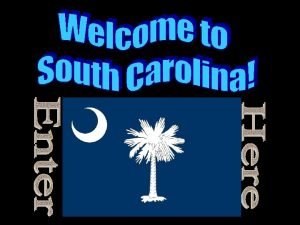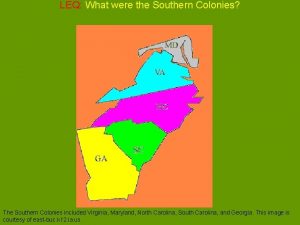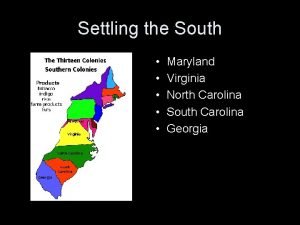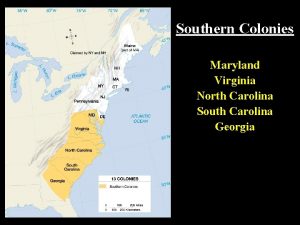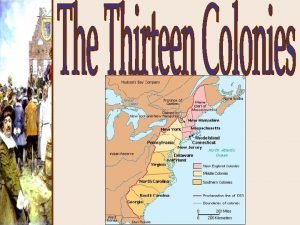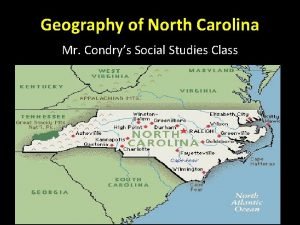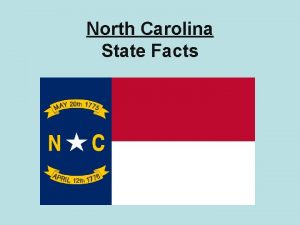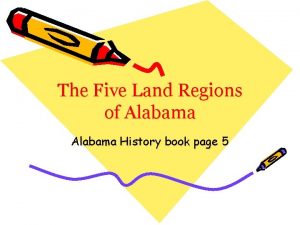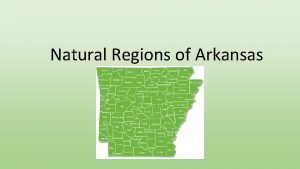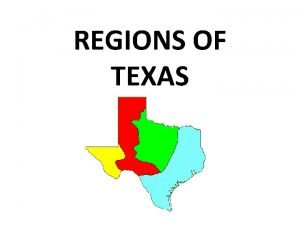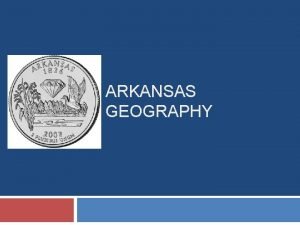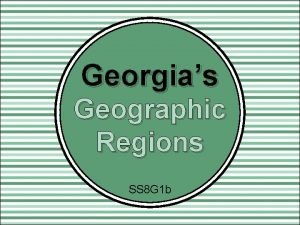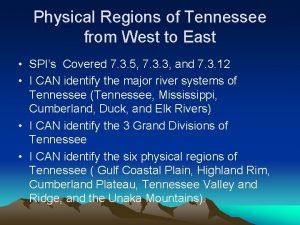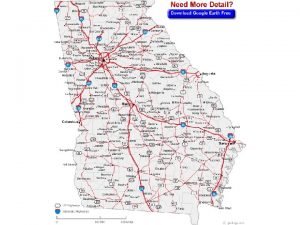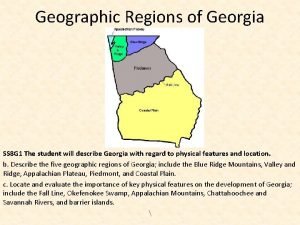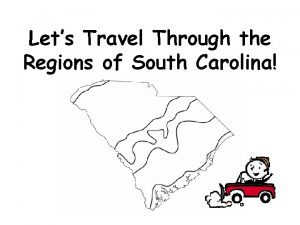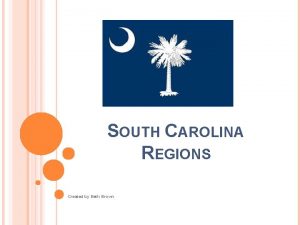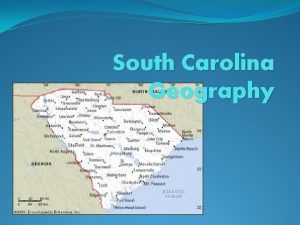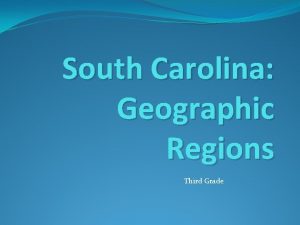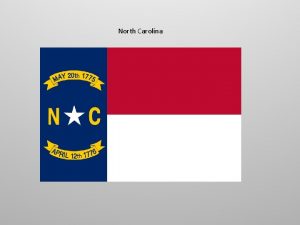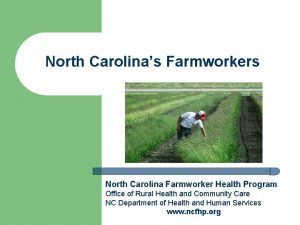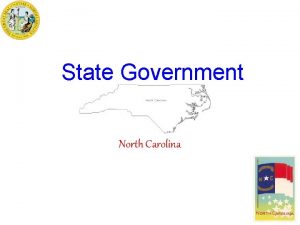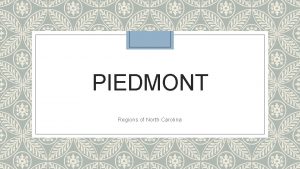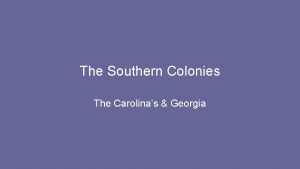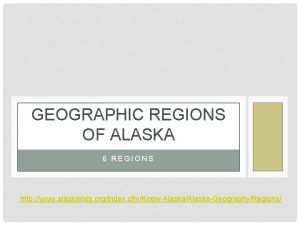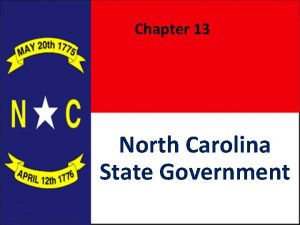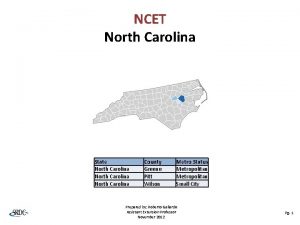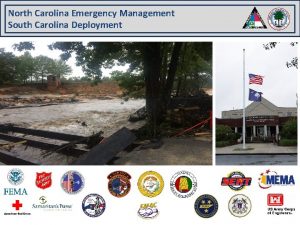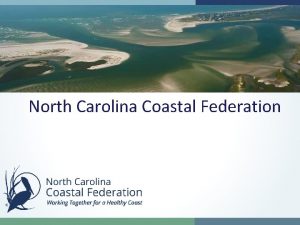North Carolina Geography North Carolinas Geographic Regions Tidewater

























- Slides: 25

North Carolina Geography

North Carolina’s Geographic Regions • Tidewater • Coastal Plain • Piedmont • Mountains

The Tidewater Region • 30 -50 miles wide strip of North Carolina (NC) along the Atlantic Ocean • Water affected by tidal shifts, often brackish • Sounds: inland areas where salt/fresh water mix

Barrier Islands • Barely above sea level, shift due to surf, storms and wind • Outer Banks are the most famous barrier islands • Inlets: low places in the sand where water from the ocean moves into the sound • Called the “Graveyard of the Atlantic”

The Sounds • Each is sound fed by fresh water from a river • Some of the oldest towns in NC are near the sounds because they are a great location for trade • Fishing is an important industry • Sediment (soil, clay, gravel) is deposited by the rivers in the sounds which makes them too shallow for large ships unless they are dredged • estuaries: salt water wetlands; these marshes are home to shellfish and shrimp Largest Sounds Currituck Albemarle Pamlico Core Bogue

Swamps and Lakes • • • pocosins: elevated wetlands I(“swamp on a hill”) with trees savanna: elevated wetland s with tall grasses mixed with various pines Most of the natural lakes in NC are in the Tidewater Lake Mattamuskeet is the largest lake, but it is very shallow(only 6’ deep) This is the least populated area of the state due to the amount of swampland

The Coastal Plain Region • Stretches from Virginia to South Carolina and is about 100 miles wide • Covers about 1/3 of the state • Rich soil and flat land make area good for farming • Crossroads hamlets: serve rural areas, usually a one or two stores, church, school, etc.

Tobacco Towns • Towns whose life and culture were dominated by tobacco farming • Largest tobacco growing area in the world • More than a half dozen tobacco warehouses per town • In mid-1900 s, nearly every town in the coastal plain had at least one tobacco warehouse • Now computer-controlled “barns” • Tobacco farming is declining – Health concerns • Longleaf pines were cut down for tobacco farming

Carolina Bays • Carolina Bays are an unusual feature of the state • Hundreds of elongated depressions in the ground, from ½ to 2 miles long and a mile wide • Some filled with water; others are wet and mucky in wet times, and dry other parts of the year • Origin unknown

The Sandhills • Located northwest of the bays • Sandy, rolling ridges left by ancient coast of the Atlantic Ocean • Very poor soil • Used as home for golf courses and Fort Bragg

The Piedmont Region • Large region of NC known for hills and red clay soil • Red clay is a subsoil brought up through the black woods dirt as a result of timber loss and plowing fields • Kudzu brought from Asia to reduce erosion and save the soil • This fast growing vine has grown like a weed and covered thousands of acres in the state

The Fall Line • fall line: divides the coastal plain from the Piedmont – noted by the last “waterfall” a river hits on its way to the ocean • Piedmont: from Latin, means “foot of the mountains” • Technically, the Piedmont is a plateau, but it’s hilly • Over ½ of region forests; pines cover old farms • biological succession: fast-growing pines die off and give way to oaks and hickory trees

Cities and Universities • The Piedmont Region is home to North Carolina’s largest cities: Charlotte, Raleigh, Greensboro, Winston-Salem, Durham, High Point etc. . . • UNC-Chapel Hill, Wake Forrest University, NC State, and Duke University all fall within the Piedmont’s boarders.

Farms and Factories • Soil made farming difficult in the Piedmont • Livestock and dairy farms were more profitable, but have declined • Economy of the region has depended on factories to produce textiles, furniture and cigarettes • mill villages: clusters of homes in a town where mill workers lived; the company often provided the homes, schools, and stores • 1990 s: decline in industry • Textile and furniture factories moved to Asia

Banking and Racing • Charlotte: national banking center and home to NASCAR, and NASCAR Hall of Fame • Winston-Salem and Durham have grown in medical service industries linked to Wake Forest and Duke Universities • Salisbury: home to grocery industry • Research Triangle Park: leader in pharmaceuticals and computers

The Uwharries • monadnocks: geological formation in which a point of land sticks out due to erosion of surrounding land (ex. Pilot Mountain on pages 3 and 24) • Uwharrie Mountains: cluster of monadnocks south of Greensboro (ex. Morrow Mountain) – slopes and slate soil discouraged settlement

The Mountains Region • Blue Ridge: more than 1, 000 ft above the Piedmont hills; eastern boundary of the Appalachians • Blue Ridge Parkway: road that runs along the top of the ridge Cherokee NC to Waynesboro, VA • Continental Divide – steams on the east run to the Atlantic; streams on the west run to the Gulf of Mexico

The Blue Ridge • Runs from Pennsylvania to Georgia • One long landform (like the barrier islands) with peaks and gaps • Early settlers depended on gaps to get through the mountains • Areas in the west very isolated • 1870 s: tunnels and road beds laid through Swanannoa Gap – near current I-40 from Old Fort to Black Mountain

The Appalachians • • Run from New York to Alabama 43 peaks in NC over 6, 000 feet Mt. Mitchell (6, 684 ft): highest point east of the Rockies Ranges – Black Mountains: known for dark shadows during thunderstorms – Great Smoky Mountains: dew rises in mists creating a smoky effect Balsams: large number of balds (places where few trees grow) example: Wayah Bald

Mountain Streams and Rocks • • • Rivers run north and west out of NC New River and French Broad are examples Asheville is largest city in the region Cherokee built their villages along the Tennessee River Most of the over 100 lakes are manmade Fontana Dam (1930 s) is highest in eastern US ; built to provide cheaper electricity

The Mountains Economy • • • Early settlers isolated from others Farming, traveling, trading were more difficult Towns developed in valley areas Known for sales of local plants with medicinal properties Tourism is a major industry • Christmas tree is a new and growing industry; Fraser firs most popular

NC Weather and Climate • weather: short-term atmospheric conditions • climate: long-term atmospheric conditions • temperate climate: general climate zone for NC; known for few extremes of temperature or precipitation • Day-to-day weather, however, varies

Heat and Humidity • Westerly winds bring warmer air in the winter and cooler air in the summer – keeps temperatures similar across the state • Mountain peaks usually coldest; Sandhills usually the warmest • -34°F: record Mt. Mitchell

Storms • Precipitation rates vary across the state • SW mountains get most rain; Piedmont is the driest region (precipitation is blocked by the mountains) • Mountains get most of the snow • Ice • Thunderstorms all over NC in summer • Some tornados • 3 rd in US in deaths due to lightning

Hurricanes • Hurricane season: June – November, peaks in September • Storm surge (huge tide on the beach); Wind (can destroy homes, trees, property); Flooding (slowing storm rapidly dumps the tropical rain) • 1845 • Hazel (1954) • Floyd (1999) • Hugo (1989)
 South carolina regions
South carolina regions Map of north carolina and south carolina
Map of north carolina and south carolina Maryland virginia north carolina south carolina and georgia
Maryland virginia north carolina south carolina and georgia Virginia, maryland, north carolina, south carolina, georgia
Virginia, maryland, north carolina, south carolina, georgia Georgia, south carolina, north carolina, virginia, maryland
Georgia, south carolina, north carolina, virginia, maryland Geography of north carolina
Geography of north carolina Carolinas ghin support
Carolinas ghin support North carolina's state bird
North carolina's state bird Geographic regions final jeopardy
Geographic regions final jeopardy Physiographic regions of alabama
Physiographic regions of alabama Which of georgia's geographic regions is the smallest?
Which of georgia's geographic regions is the smallest? Geographic regions final jeopardy
Geographic regions final jeopardy Arkansas six regions
Arkansas six regions Regions of tx
Regions of tx Geographic regions of arkansas
Geographic regions of arkansas Blue ridge region
Blue ridge region Physical regions of tennessee
Physical regions of tennessee Ga geographic regions
Ga geographic regions Georgia geographic region
Georgia geographic region Tidewater disc golf course
Tidewater disc golf course Tidewater advanced soccer league
Tidewater advanced soccer league Walk to emmaus letter example
Walk to emmaus letter example Va reconsideration of value circular
Va reconsideration of value circular South carolina regions song
South carolina regions song South carolina regions
South carolina regions South carolina regions
South carolina regions
